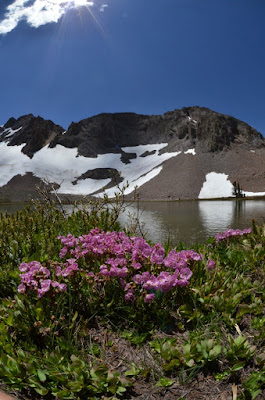 |
| Sierra Nevada wilderness areas in eastern California. Map from www.sierrawild.gov. |
The Sierras boast a string of wilderness areas from
Desolation and Granite Chief near Lake Tahoe to Yosemite
and Ansel Adams in the central Sierra to a constellation of smaller
wildernesses in the south Sierra. I have not visited most of these, but
yesterday I did a day hike in the Mokelumne Wilderness that intersects three
national forests just south of Lake Tahoe . It
was gorgeous.
 |
| Round Top Lake and "The Sisters" with Kalmia polifolia (swamp laurel) in the foreground. |
Starting near Woods
Lake , I headed south on the Lost Cabin
Mine trail with my first major destination being Round Top Lake Round Top Lake
From the Round Top area, I descended southward into a valley
of sorts, switching back and forth down the slope to Fourth of July Lake. It
was about a thousand foot descent. This northern part of the Mokelumne
wilderness is a popular hiking and camping destination, but despite a few signs
of human impacts, the beautiful landscape was untrammeled.
 |
| Looking south into the Mokelumne Wilderness with Fourth of July Lake near center. |
 |
| Erysimum sp. (wallflower). |
Wildflowers were abundant throughout my hike, and at higher
elevations they included bright white patches of Phlox, and stalks of wallflowers, exploding in vibrant yellow
almost like little fireworks from the grey soils. On the descent down to Fourth
of July Lake, plant diversity increased markedly. Delicate pink blooming Sidalcea became increasingly common and
I also observed Maianthemum racemosum
that appeared to have a more yellow inflorescence than I’m familiar with from the
plants I recall from the Oregon Cascades.
A ring of forest surrounded Fourth of July Lake and included
mountain hemlock, pines, firs and even some short alders at the water’s edge.
Snowmelt fed a stream of sorts that entered the 8160 ft elevation lake from the
west, and it made little waterfalls cascading down the steep granite slopes
that hug the northern and western sides of the lake.
Wildlife seemed a little sparse on my hike – some birds, a
few chipmunks and an unknown larger mammal that left my sight just after
noticing it. There were beetles, ants, mosquitos, butterflies and tiny fish in Round Top
Lake
 |
| From left to right: Sidalcea sp., assorted lichens, ridge on the far side of Summit City Creek valley. |
No comments:
Post a Comment